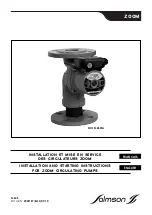
(D)
Priming:
A centrifugal pump must be primed before it can be operated. If run dry, damage can occur to close-
clearance rotating parts and will destroy mechanical seals. If not primed properly, it will not deliver fluid.
Prime in one of the following methods:
1.
If system has suction pressure, slowly open the suction valve. Open air vents on the pump casing and
suction and discharge piping until fluid runs out. Rotate shaft a few times if possible to evacuate any
trapped air in the impeller passages. Close all vent valves.
2.
If the system has suction lift and there is a foot valve in the suction pipe, fill the pump casing and
suction pipe with the liquid to be pumped. At the same time let any trapped air escape.
3.
If the system has a suction lift but no foot valve, use a vacuum pump or ejector operated by air, steam,
water, engine exhaust, etc., to evacuate the air from the pump case and suction pipe. Connect the ejector
to the gauge connection at the top of the discharge nozzle, if provided.
(E)
Starting the Pump:
Turn the pump shaft by hand to ensure that the rotating element is free. If the rotating
element rubs or binds, check for any abnormal piping strain or other loads on the pump causing misalignment.
A slight drag from the mechanical seal is normal.
1.
Check that the voltage and frequency on the motor nameplate match the current supply. Be sure the
motor is wired for correct voltage. Check that all thermal overload relays are of the proper size and "set"
for operation.
2.
Be sure the valve in the suction line is open. Never use the suction line valve to control flow.
The discharge valve should be dosed or partially open. See that all pipe connections are tight. Make
sure all flushing and. cooling lines are open.
3.
Restore power supply and start the pump motor/driver. As soon as pump reaches full speed, slowly
open the discharge valve.
Do not operate the pump below minimum rated flow levels or against a closed discharge valve for prolonged
periods of time. This can cause increased vibration levels which will affect seal and bearing life. It can also
cause cavitation damage to the internal surfaces of the pump.
4.
If hot liquid is pumped, control opening of discharge valve to allow pump temperature to stabilize before
reaching full capacity. Observe the operation of the pump. If excessive vibration or noise is evident, the
unit should be stopped immediately and a thorough check made of the installation to determine the cause.
Correct any fault before restarting the pump.
5.
Listen for rubbing or binding which may have been caused by piping strains. If present, shut down the
pump immediately. Investigate and correct the cause before restarting the pump.
6.
Check the packing/mechanical seal for proper operation. Packing should have a leakage rate between 40
to 60 drops per minute. Never force the packing into a leakproof position since this will create excessive
friction and premature damage to the packing and shaft or shaft sleeve. If leakage is excessive, tighten
the gland bolts evenly, about 1/4 turn at a time. Allow the packing to seat in its new position. Packing
must be "run-in" and this could take several hours or days to achieve the desired results.
Mechanical seals are installed and adjusted at the factory. No further adjustment is required except for
a short run-in period.
Page 22
4852840
WARNING:
Summary of Contents for Peerless Pump 8196 Series
Page 47: ...Engineering Data 4852840 Page 47...
Page 48: ...Pump Trouble Shooting Common Pump Operational Problems Page 48 4852840...
Page 50: ...ModularInterchangeabilityChart Page 50 4852840...
Page 51: ...STP Exploded Isometric View 4852840 Page 51...
Page 52: ...MTPExploded IsometricView Page 52 4852840...
















































